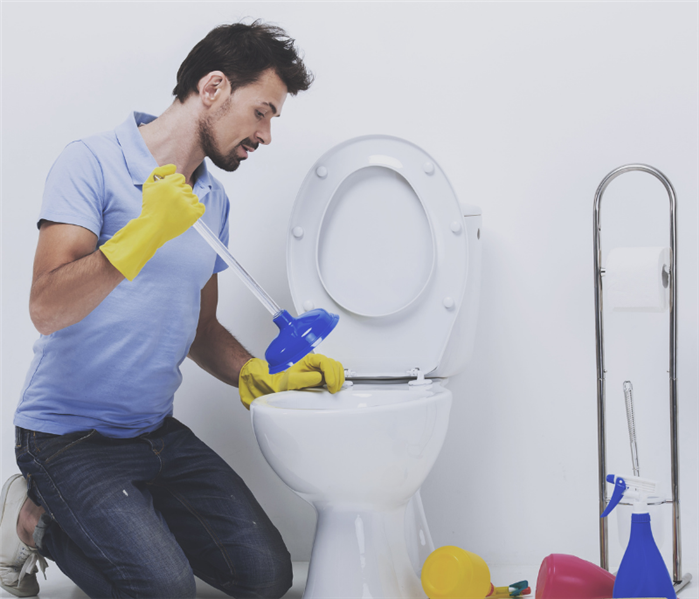What To Do When The Toilet Overflows
10/12/2020 (Permalink)
Toilet overflows are a nightmare for any homeowner regardless of the cause. If not handled quickly, you may have considerable water damage from the toilet overflow, especially if it happens on an upper level of your home. Here, we will go over what to do when you find water pouring out of your toilet and what damages you should be aware of.
What To Do When Your Toilet Overflows
Avoid using all plumbing if you're not sure what is causing the overflow.
If the toilet began to overflow immediately after flushing, it is likely just clogged and may be an easy fix. If the overflow occurred without flushing, it is likely that there is a clog somewhere in the main drain or sewer line. When this happens, running water exiting your home has nowhere to go and will backflow to the toilet or shower. Unless you are sure of the issue, try not to use the water to prevent additional damages to your home.
Turn the water off to the toilet.
There are multiple ways to do this. The first way is to turn the valve on the wall behind the toilet off to cut the water supply. If you cannot find this, you can take the lid off the toilet tank and lift the float high enough so that the water stops running and in turn stops filling the toilet bowl. From there, you can turn off the main water valve to your house which is likely located near your water heater.
If water continues to flow after shutting off the water, immediately call a plumber.
This means that you're not just dealing with a toilet clog, but likely a sewage backup from your septic tank or your city's septic system.
Clear the clog.
This can be accomplished a few ways and should be tried in this order. Before taking any of these steps, grab a pair of gloves and a bucket to remove some of the excess water from the toilet. This will help prevent splashing the water on to the floors, walls, or yourself during this process.
- Plunge the clog - Get a plunger with a flange on the bottom that will create a tight seal around the toilet drain hole to best dislodge the clog. Keeping the plunger upright, push up and down for about 15 to 20 seconds to force water and air into the drain. The toilet may begin to drain itself or require you to flush again to completely clear the clog.
- Snake the drain - A toilet snake is a flexible cable that can navigate through the twists and turns of the toilet drain. Put the hook end of the snake into the toilet bowl and turn the crank on it clockwise to extend the cable down into the drain. When you can't go any further, you've found your clog. Then, turn the crank counter clockwise to pull the clog out of the drain and pour it out into a bucket. Perform this process a few times to be sure you've completely gotten rid of the clog. Then, pour what you have in your bucket back into the toilet in small amounts to properly dispose of it.
- If neither of these work or the second option seems like more than you can (or want) to handle, call a local plumbing professional to do it for you.
Clean up standing water - if safe to do so.
If the water that comes out of your toilet is clean water from a toilet malfunction, you may be able to clean up water yourself with proper protective equipment. But, if this water has any foreign objects or contaminants such as waste - you should call a professional water damage restoration company to do the cleanup for you. Contaminated water is dangerous and can contain raw sewage, bacteria, or other microorganisms which can make you extremely ill when you come in contact with it.
What Damage Can A Toilet Overflow Cause?
Even when you clean up the water from a toilet overflow yourself and don't see any damage doesn't mean it's not there. Depending on where the overflow happened and for how long, the water from it can damage:
- Drywall
- Subfloors
- Flooring
- Ceilings of lower level rooms
- Carpet
- Insulation
- Electrical wiring
- Produce mold growth
When a toilet overflow happens to you, it's best to call a water damage restoration service that can work directly with your insurance company. These companies are sure to remove all water, completely dry your property, and properly clean & sanitize afterwards to ensure your family does not experience health effects and that no mold will grow.
Need Help After A Toilet Overflow? Call SERVPRO - 860-388-1776
SERVPRO of Old Saybrook is a 24/7 emergency service specializing in water damage, fire damage, mold remediation and COVID-19 disinfection services. Don't wait for damage to get worse, call SERVPRO to make it "Like it never even happened."






 24/7 Emergency Service
24/7 Emergency Service
